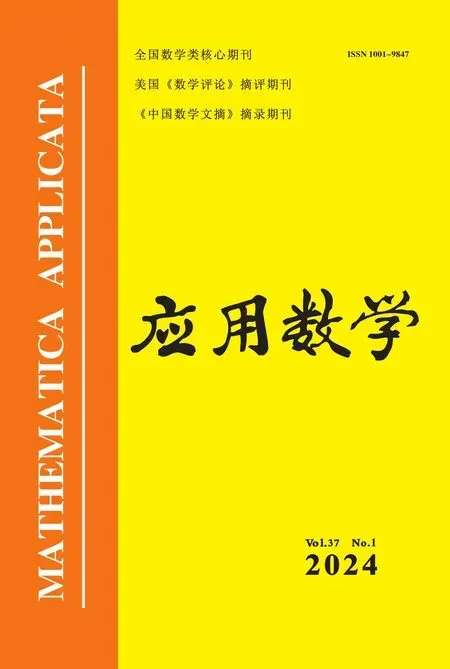Global Regularity for the 3D Tropical Climate Model with Partial Viscosity and Damping
ZENG Ying(曾颖),BIE Qunyi(别群益)
(College of Science, China Three Gorges University, Yichang 443002, China)
Abstract: In this paper,we study the three dimensional tropical climate model with damping |u|α-1u on the barotropic mode of the velocity.By using the energy estimation,we obtain the global existence and uniqueness of a strong solution when α ≥4 and β ≥
Key words: Tropical climate model;Global well-posedness;Strong solution;Damping
1.Introduction
In this paper,we consider the following three dimensional tropical climate model with partial viscosity and damping:
When there is no damping in the system (1.2),i.e.,σ=0,the global regularity results have been investigated in [1-3] etc.Whenσ,µ,ν,η=0,the system (1.2) reduces to the original tropical climate model derived by Frierson,Majda and Pauluis[4].In this case,YE and ZHU[5-6]considered the global strong solutions when the viscosity depends on the temperature.
Whenσ>0 in (1.2),MA and WAN[7]showed the global well-posedness for the small data.YUAN and CHEN[8]obtained the global existence and uniqueness of the strong solution provided thatα ≥4 and
withm>
On the other hand,when there are damping termsσ2|w|β-1wandσ3|θ|γ-1θin (1.2)2and(1.2)3,respectively,YUAN and ZHANG[9]proved that there exists the global and unique solution whenα,βandγsatisfy some conditions.Berti,Bisconti and Catania[10]established a regularity criterion,thanks to which the local smooth solution (u,w,θ) can actually be extended globally in time.
For some global regularity results for the Navier–Stokes equations,micropolar equations and MHD equations with damping terms,we can refer to[11-14].Let us mention that in[14],LIU et al.studied the existence and uniqueness of a global solution for the three-dimensional Boussinesq-MHD equations with partial viscosity and damping.
Motivated by the works mentioned above,we will consider the system (1.1),which is the case for the system(1.2)with partial viscosity and damping.We focus on the global existence and uniqueness of the strong solution to the system (1.1).
Before stating our main theorem,we shall introduce some notations and functional settings used in the sequel.Since the horizontal variablexh:=(x1,x2)plays a different role with the vertical variablex3,it is natural to introduce the so called anisotropic Sobolev spacesfor alls,s′∈R,that is,the spaceis the Sobolev space with regularityHsinxhandHs′inx3.It is easy to check thatL2=H0,0andH1=H1,1.Moreover,we shall use the notation∇h:=(∂1,∂2).
Definition 1.1We call the function (u(x,t),w(x,t),θ(x,t)) the strong solution of the system (1.1) if it is a weak solution of (1.1) satisfying
Now,we state our main result as follows.
Theorem 1.1Letu0∈H0,1(R3),w0∈H1(R3),θ0∈H1(R3)such that divu0=0,α ≥4 andβ≥.Then,the system (1.1) admits a unique global solution (u(x,t),w(x,t),θ(x,t))satisfying
Moreover,the solution (u(x,t),w(x,t),θ(x,t)) depends continuously on the initial data.
2.Proof of Theorem 1.1
This section is devoted to the proof of Theorem 1.1.By a priori estimates and taking limits of the Galerkin approximated solutions,we can obtain the existence of a global strong solution.Therefore,in the sequel,we give a priori estimates and prove Theorem 1.1 by standard procedure.
We split this section into two parts.The first part is for the existence while the second one is for the uniqueness.
Step 1 A priori estimates
First,multipling (1.1)1,(1.1)2and (1.1)3byu,wandθ,respectively,and summing them up,we get after integrating by parts that
Integrating with respect tot,we arrive at
Thus,it holds that
Next,we shall obtain estimates of the derivative of (u,w,θ).To this end,we multiply(1.1)1by-and use integration by parts over R3to get
Similarly,we deduce from (1.1)2and (1.1)3that
and
Summing up (2.4),(2.5) and (2.6),we obtain
It is the position to estimate the terms on the right hand of (2.7).First,using the H¨older inequality and Gagliardo-Nirenberg inequality,we have
where we use the fact∂3u3=-∂1u1-∂2u2.
Next,we estimateI11(t) andI12(t).Forα ≥3,one has
RegardingI12(t),applying the H¨older and Young inequalities,we get forα ≥3 that
ForI2(t),applying integration by parts,we obtain
ForI4(t),applying the Sobolev embedding,H¨older and Gagliardo-Nirenberg inequalities,we have
ForI6(t),using the Young and Gagliardo-Nirenberg inequalities,we deduce
With respect toI7(t),applying the H¨older,Young and Gagliardo-Nirenberg inequalities,we have forα ≥4 that
ForI8(t),using the Young inequality,we get
SubstitutingIi(i=1,2,···,8) into (2.7),we have
Applying Gronwall’s inequality to (2.18),we obtain that
Strictly speaking,the a priori estimates in Step 1 is applicable to the approximate solution constructed by the Friederich’s regularization method (see [15],Chapter 6).Therefore,it can only be transmitted to the limit in the sequence of solutions.We focus on the limit of the nonlinear terms.Through Step 1,we have∇un ∈L2(0,T;L2(R3)).Using the Rellich-Kondrachov theorem in [16],we obtain thatunis the strong convergence inL2(0,T;L2(R3)).
Letϕbe a test function.We have
For all the other nonlinear terms,we get the convergence by using the similar method.Thus,the existence of solution to the system (1.1) is proved.
Step 2 Uniqueness
Now,multiplying(2.21)1,(2.21)2and (2.21)3byf,gandq,respectively,integrating over R3,and summing them up,we get after integrating by parts that
First,the last term on the left hand of (2.22) is handled as
Making use of the H¨older,Young and Gagliardo-Nirenberg inequalities,one has
where we have used the following inequalities:
due to∂3f3=-∂2f2-∂1f1.
ForJ2(t) andJ3(t),using the H¨older,Young and Gagliardo-Nirenberg inequalities,we get
ForJ4(t),applying the H¨older,Young and Gagliardo-Nirenberg inequalities,we infer
Arguing similarly as the estimates ofJ2(t) andJ3(t),one has
Using the H¨older and Gagliardo-Nirenberg inequalities,we have
Inserting estimates (2.23)-(2.29) into (2.22) yields that
By virtue of (2.19) and(2.20),it holds thatF(t)∈(R+).Therefore,applying Gronwall’s inequality to (2.30) leads to the uniqueness.The proof of Theorem 1.1 is completed.

